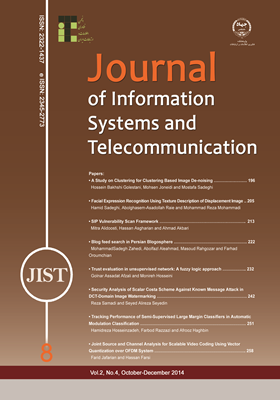Tracking Performance of Semi-Supervised Large Margin Classifiers in Automatic Modulation Classification
محورهای موضوعی : Signal ProcessingHamidreza Hosseinzadeh 1 , فربد رزازی 2 , Afrooz Haghbin 3
1 - Islamic Azad
2 -
3 - Science and Research university
کلید واژه: Automatic modulation classification, AMC, Tracking performance evaluation, Passive-Aggressive Classifier, Self Training, Semi-supervised learming, , ,
چکیده مقاله :
Automatic modulation classification (AMC) in detected signals is an intermediate step between signal detection and demodulation, and is also an essential task for an intelligent receiver in various civil and military applications. In this paper, we propose a semi-supervised Large margin AMC and evaluate it on tracking the received signal to noise ratio (SNR) changes to classify all forms of signals in a cognitive radio environment. To achieve this objective, two structures for self-training of large margin classifiers were developed in additive white Gaussian noise (AWGN) channels with priori unknown SNR. A suitable combination of the higher order statistics and instantaneous characteristics of digital modulation are selected as effective features. Simulation results show that adding unlabeled input samples to the training set, improve the tracking capacity of the presented system to robust against environmental SNR changes.
Automatic modulation classification (AMC) in detected signals is an intermediate step between signal detection and demodulation, and is also an essential task for an intelligent receiver in various civil and military applications. In this paper, we propose a semi-supervised Large margin AMC and evaluate it on tracking the received signal to noise ratio (SNR) changes to classify all forms of signals in a cognitive radio environment. To achieve this objective, two structures for self-training of large margin classifiers were developed in additive white Gaussian noise (AWGN) channels with priori unknown SNR. A suitable combination of the higher order statistics and instantaneous characteristics of digital modulation are selected as effective features. Simulation results show that adding unlabeled input samples to the training set, improve the tracking capacity of the presented system to robust against environmental SNR changes.


